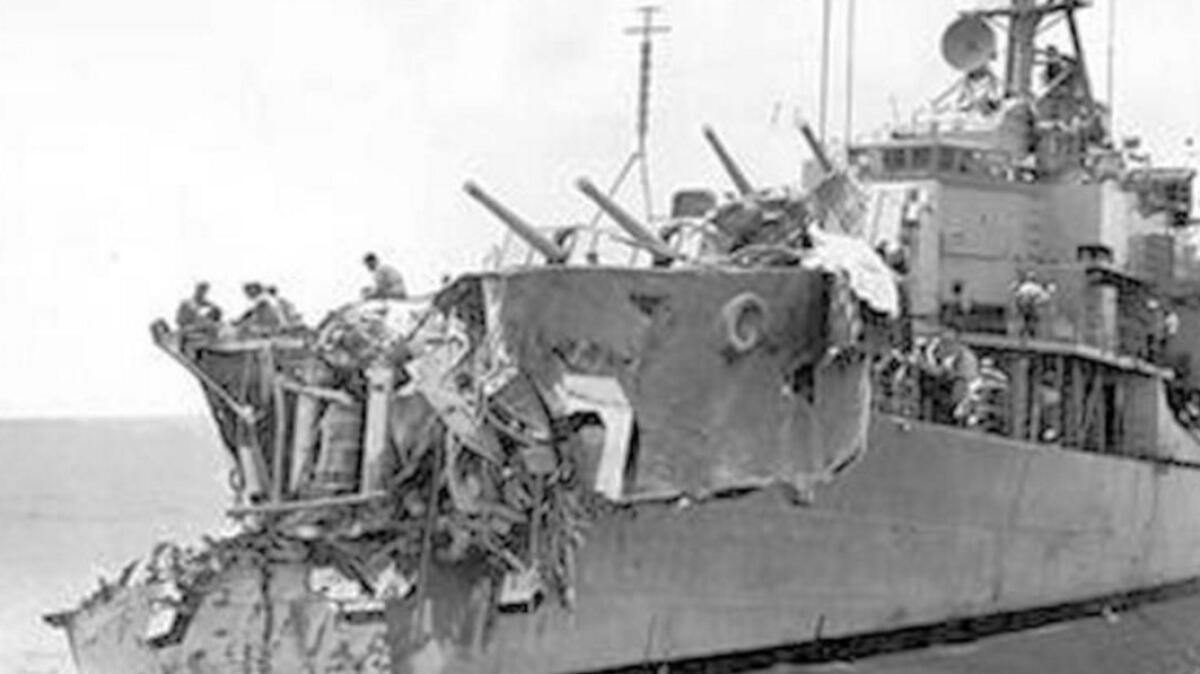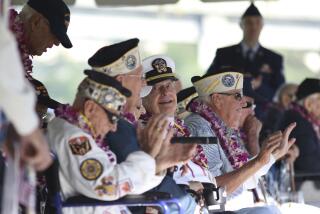On a foggy night, a deadly naval disaster off Newport Beach

It was midmorning on Tuesday, July 19, 1960, and two 376-foot U.S. Navy destroyers, foghorns blaring, were groping their way through dense fog five miles off Newport Beach.
Both ships, the Ammen, which was heading to San Diego from the Seal Beach Naval Weapons Station, where it had unloaded its ammunition, and the Collett, sailing from San Diego to Long Beach, had been in the thick of combat in the Pacific during World War II.
The Ammen had miraculously survived sinking during the 1944 Battle of Leyte Gulf when a Japanese kamikaze plane plunged deep into its superstructure, causing massive damage, killing five crewmen and critically injuring 26. The Collett had seen action at Iwo Jima, Okinawa and the Philippines, and on Sept. 2, 1945, it was moored in Tokyo Bay next to the battleship Missouri, where Gen. Douglas MacArthur received the Japanese surrender. Both ships also saw combat during the 1950-1953 Korean War.
On that fateful day off Newport Beach nearly 57 years ago, as the fog thickened and the sea became increasingly choppy, Cmdr. Zaven Mukhalian, 41, skipper of the Ammen, and his 235-man crew were presented with a sight that would strike terror in the heart of any mariner.
Out of the fog loomed the Collett, carrying a crew of 239, traveling at an estimated speed of 17 knots (19.5 mph) directly toward the slower-moving Ammen’s port side.
See the most-read stories this hour >>

Wreckage from the USS Ammen that contained three sailors’ bodies is removed in a Terminal Island drydock the day of the collision with the Ammen off Newport Beach.
Mukhalian and Cmdr. Albert T. Ford, 39, captain of the Collett, frantically ordered evasive action and instructed their helmsmen to reverse course.
It was too late.
At 9:42 a.m., the bow of the Collett sliced into the port side of the Ammen, which was due to be decommissioned and sent to the Navy’s “mothball” fleet after it reached San Diego.
The force of the impact gouged a huge hole below the Ammen’s waterline, sending water rushing in and damaging its engine, electronics repair shops and fire rooms so badly they were left looking like a “junkyard,” the Los Angeles Times noted in a Page One story the next day.
Aboard the Collett, a new bow fitted only two weeks earlier was crumpled back, its upper part pressed against the ship’s port side, its lower part ripped open and wedged against its starboard side. The Collett’s left anchor was embedded in the Ammen, and its gun control tower was sheared off at its base and lay on its side on the deck. The damage was described by The Times as “grotesque.”
The situation aboard the Ammen was much worse.
Its aft engine room and forward fire room filling with water, the ship took a sharp list, and it was feared the Ammen would turn on its side and sink. But its pumps stemmed the flooding, and the Ammen remained afloat, although still listing at a dangerous angle.
Several crewmen on the Collett, which was able to back free from the Ammen, suffered minor lacerations, cuts and bruises.
But on the Ammen, it was a different story.
Collett bow lookout Patrick Madeiros, then 19, who told the Associated Press that he had yelled “ship dead ahead!” when he realized his vessel was rapidly approaching the Ammen, said he heard the awesome sounds of disaster coming from the Ammen when the two vessels collided.
“Frantic shouts ... the clanging of bells ... death screams ... the hiss of steam ... the rip and tear of steel,” he recounted.
The death toll on the Ammen reached 11. All those killed were enlisted men. At least 20 other crewmen were injured. The force of the collision was so great that two Ammen crewmen – one died later that day, and the other was critically injured -- were catapulted from the deck of the Ammen to the deck of the Collett.
Most of the dead and injured had been in the Ammen’s fire and engine rooms when the ships collided. There had been a foreboding of disaster among some of the officers and men aboard the Ammen just before the ramming.
“If we collide with another ship in this fog, we won’t have a chance,” crewman Royce L. Jones recalled he had warned his shipmates.
Join the conversation on Facebook >>
Mukhalian stated at a Long Beach news conference that evening, “If we hadn’t unloaded our ammunition, including the depth charges, at Seal Beach before the collision, both ships would have been blown to kingdom come.”
In Newport Beach, rescue operations began at once when authorities were alerted to the disaster.
Learning of the collision from Coast Guard and Navy radio reports, Newport Beach’s lifeguard rescue boat the Sea Watch and the Harbor Department’s Boat No. 2 raced to the scene in heavy fog and choppy seas.
Boat No. 2 was the first to arrive, and Bob McBride, one of its crew, told the daily Globe-Herald and Pilot (which a year later became the Daily Pilot), “There was no panic aboard the ships when we came alongside and started to take off the injured.”
Stan Annin, deputy chief of the Newport Beach Harbor Department who was aboard the Sea Watch, told Almon Lockabey, the Globe-Herald and Pilot’s boating and marine editor, “It was so foggy that we couldn’t see more than an eighth of a mile.”
Wreckage on the Ammen’s deck was “terrific. Cabins were caved in. The Ammen’s deck, which was only five feet above water, was crushed like a beer can,” wrote Lockabey, a fixture on the Orange Coast boating scene who died in 1995 at the age of 85.
The Island Lady, a Newport-Catalina tourist boat, joined in the evacuation, assisting in the removal of the Ammen’s dead and injured as the ship continued its list, raising fears it might turn over.
About 11:30 a.m., the dead and injured had been taken off the Ammen, and the Collett, assisted by a Navy tugboat, was able to limp under its own power to the Long Beach Naval Base. The Ammen, still listing and its engine inoperable, was towed to the Long Beach Naval Shipyard by the Gear, a submarine rescue ship.
A week after the disaster, a Navy court martial heard testimony from the captains of the Ammen and Collett that their ships’ radars were working properly before the crash and that they could not explain why the two warships had come together with such destructive force.
NEWSLETTER: Get the day’s top headlines from Times Editor Davan Maharaj >>
Four months later, on Nov. 11, 1960, The Times reported that Ford had pleaded guilty to negligently handling his ship, but that he had pleaded not guilty to not maintaining adequate watches on his ship’s bow and in the radar room.
The court reprimanded him and sentenced him to the loss of 100 numbers on the Navy promotion list. This effectively banned him from promotion to the rank of captain and ended his Navy career.
As for the futures of the two vessels, the Ammen was patched up at the Long Beach Naval Shipyard and towed to San Diego, where it was decommissioned and sold for scrap the following year to the National Metal and Steel Corp.
The Collett was fitted with its second new bow in three months and returned to active duty, conducting patrols in the Pacific and along the California coast. In 1974, it was bought by Argentina to serve as a spare parts ship for the nation’s navy. The Argentines found that the Collett was in such good shape that they renamed the ship the ARA Piedrama and added it to their seagoing inventory.
During the 1982 Falklands War with Britain, the Piedrama served as an escort ship and rescued the survivors of the Argentine cruiser General Belgrano, which was sunk by the British attack submarine Conqueror.
------------
For the record
10:30 a.m., May 31: An earlier verson of this post misspelled the name of the Argentine cruiser sunk during the Falklands War. It was the General Belgrano, not Belgramo.
------------
Three years later, the 31-year-old Collett was decommissioned by the Argentine navy and sunk by guided missiles during a naval exercise.
Today, more than a half-century after the two destroyers collided off Newport Beach, the tragedy remains one of the worst peacetime sea disasters in U.S. Pacific Coast naval history.
ALSO
FBI agent’s gun and credentials stolen from vehicle in San Francisco
Investigators continue to search for leads in disappearance of Pearl Pinson
‘Don’t roofie someone on our watch’: Man arrested in alleged attempt to drug date
More to Read
Start your day right
Sign up for Essential California for news, features and recommendations from the L.A. Times and beyond in your inbox six days a week.
You may occasionally receive promotional content from the Los Angeles Times.





